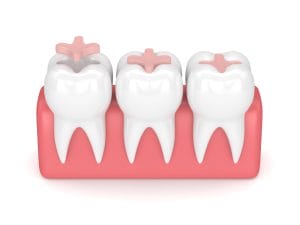
The Basics of Dental Inlays and Onlays
Inlays and onlays are restorative dental procedures used to repair teeth damaged by tooth decay or trauma. They are indirect fillings custom-made in a dental laboratory to fit precisely into the affected tooth. Inlays cover a specific area within the cusp of the tooth, while onlays are larger, extending over the chewing surface. These options provide a more durable and natural-looking alternative to traditional fillings, preserving more of the natural tooth structure and avoiding the need for a root canal.
Defining Inlays and Onlays
Inlays and onlays are indirect fillings used to restore teeth affected by tooth decay or damage. Unlike standard fillings, they cover a larger area of the tooth and are fabricated in a dental laboratory before being bonded to the damaged tooth. Inlays, specifically, are used to restore cavities that are centered in the tooth, while onlays cover one or more cusps. These restorations help preserve the natural tooth structure and provide a more durable solution compared to basic fillings.
How Inlays and Onlays Differ from Standard Fillings
Inlays and onlays differ from standard fillings by being indirect restorations fabricated in a dental laboratory, unlike basic fillings done chairside. These restorations cover a larger area and are best suited for teeth with more extensive damage or decay. Unlike traditional fillings, inlays and onlays preserve more natural tooth structure and provide a durable, long-lasting solution. They offer a middle ground between regular fillings and dental crowns, making them a preferred choice for many individuals seeking more extensive dental treatment options with stronger and more reliable filling material.
Benefits of Opting for Inlays and Onlays
Durability and Longevity: Inlays and onlays offer exceptional durability, lasting longer than traditional fillings, maintaining the natural tooth structure. Aesthetic Advantages: These restorations provide a seamless look, matching the color of your natural teeth. Preserving Tooth Structure: Unlike standard fillings, inlays and onlays protect and strengthen the tooth, minimizing the risk of further decay or damage.
Durability and Longevity
Inlays and onlays offer exceptional durability and longevity compared to standard fillings. Crafted from robust materials like gold, porcelain, or composite resin, these restorations can withstand the rigors of daily use, providing lasting protection to the damaged tooth. Their precise fit and ability to strengthen the natural tooth structure contribute to their longevity, making them a superior choice over resin fillings which are known to discolor over time. By opting for inlays or onlays, individuals can enjoy extended durability, reducing the need for frequent replacements and enhancing overall oral health. Choosing these options ensures a long-lasting dental solution.
Aesthetic Advantages
Beyond their functional benefits, inlays and onlays offer notable aesthetic advantages. These restorations blend seamlessly with natural teeth, providing a perfect color match. Their ability to mimic the natural tooth structure ensures a visually appealing result. Unlike traditional metal fillings, inlays and onlays do not darken over time, maintaining a bright and natural look. This aesthetic appeal makes them a popular choice for individuals seeking both durability and visually pleasing dental restoration.
Preserving Tooth Structure
Preserving tooth structure is a key benefit of opting for inlays and onlays. Unlike traditional fillings, these restorations require less removal of healthy tooth material, as they are bonded directly onto the tooth. By maintaining more of the natural tooth structure, inlays and onlays help to strengthen the tooth and prevent further damage. This conservative approach ensures that the integrity of the tooth is retained while providing long-lasting support and protection.
Ideal Candidates for Inlays and Onlays
Ideal candidates for inlays and onlays are individuals with larger areas of damaged tooth material, beyond what a basic filling can restore. Those with minor tooth decay or fissures of a tooth can benefit from this type of dental restoration. Patients who prioritize preserving their natural tooth structure while opting for a durable and long-lasting solution often find inlays and onlays to be the best option. Understanding your dental health status is essential in determining if inlays or onlays are suitable for you.
Criteria for Choosing Inlays or Onlays Over Other Treatments
In deciding between inlays/onlays and alternative treatments, factors like the extent of tooth damage, the desire to preserve natural tooth structure, and the longevity of the restoration are pivotal. For individuals with moderate to extensive damage, inlays/onlays offer a more durable and conservative option compared to conventional fillings. They are particularly beneficial when the damaged area requires more than a basic filling but not so much damage that a full dental crown is required. Understanding these criteria helps in making an informed choice for optimal oral health.
Understanding Your Dental Health Status
Assessing your dental health status is crucial when considering inlays and onlays. Factors like the extent of tooth damage and overall oral health play a pivotal role in determining the best treatment option. Your dentist will evaluate the condition of the affected tooth and check if inlays or onlays suit your specific case. Understanding your dental health status ensures the most suitable choice for preserving your natural tooth structure and achieving optimal oral health.
Enhance Your Smile Today
In conclusion, understanding dental inlays and onlays can significantly benefit your oral health. These restorative treatments offer superior durability, aesthetics, and tooth structure preservation compared to standard fillings. Ideal candidates for inlays and onlays should consider their durability, aesthetic advantages, and ability to maintain tooth structure. The procedure involves thorough examination, preparation, fabrication, and fitting for optimal results. Materials like gold, porcelain, and composite resin are commonly used for inlays and onlays, catering to individual preferences and needs. If you’re seeking long-lasting dental solutions with enhanced aesthetics, inlays and onlays could be the ideal choice for you. Contact us today at Stiles Dental Care for more!
